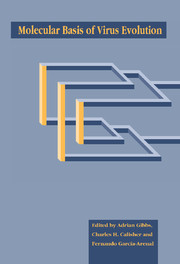Book contents
- Frontmatter
- Contents
- List of contributors
- Editors' preface
- Conference participants
- 1 Introduction and guide
- Part I The impact of viral diseases
- Part II Origins of viruses and their genes
- Part III Sources of virus variation
- Part IV Molecular interactions of viruses and their hosts
- Part V Viruses, hosts and populations
- 13 Quasi-species: the concept and the word
- 14 The co-evolutionary dynamics of viruses and their hosts
- 15 Population genetics of viruses: an introduction
- 16 Origin and evolution of prokaryotes
- 17 Molecular systematics and seed plant phylogeny: a summary of a parsimony analysis of rbcL sequence data
- Part VI Case studies of viral taxa; their systematics and evolution
- Part VII Techniques for viral systematics
- Index
13 - Quasi-species: the concept and the word
Published online by Cambridge University Press: 04 May 2010
- Frontmatter
- Contents
- List of contributors
- Editors' preface
- Conference participants
- 1 Introduction and guide
- Part I The impact of viral diseases
- Part II Origins of viruses and their genes
- Part III Sources of virus variation
- Part IV Molecular interactions of viruses and their hosts
- Part V Viruses, hosts and populations
- 13 Quasi-species: the concept and the word
- 14 The co-evolutionary dynamics of viruses and their hosts
- 15 Population genetics of viruses: an introduction
- 16 Origin and evolution of prokaryotes
- 17 Molecular systematics and seed plant phylogeny: a summary of a parsimony analysis of rbcL sequence data
- Part VI Case studies of viral taxa; their systematics and evolution
- Part VII Techniques for viral systematics
- Index
Summary
Introduction
A type of dynamic genetic organization of a population in which individual genomes have a fleeting existence, and usually differ in one or more positions from the consensus or average sequence of the population, is known as a quasi-species. Quasi-species have been found among viruses with RNA genomes and originate as a result of the high mutation rates during RNA replication and reverse transcription, as well as in the competition among continuously arising variant genomes. Because the concept of the quasi-species is of fundamental importance to understand RNA viruses, in this brief chapter we address the origins of the idea, summarize its biological relevance by referring the reader to other articles and reviews, and discuss the adequacy of the term quasi-species.
Historical background: the origins
The quasi-species concept had two origins: one theoretical and the other experimental.
The first theoretical treatment of a system involving regular generation of error copies by replication with limited fidelity was by one of the authors (Eigen, 1971) in considering earliest life forms on earth. This study was stimulated by Sol Spiegelman's experiments on in vitro replication of Qß RNA, and a ‘breakfast discussion’ with Francis Crick. ‘Self-instructive’ behaviour was distinguished from ‘general autocatalytic’ behaviour, the former being required for ‘template’ activity. A quality factor was defined which determines the fraction of copying processes that leads to an exact copy of the template. The ‘master copy’ will produce ‘error copies’ which will occur with a certain probability distribution.
- Type
- Chapter
- Information
- Molecular Basis of Virus Evolution , pp. 181 - 191Publisher: Cambridge University PressPrint publication year: 1995
- 40
- Cited by



